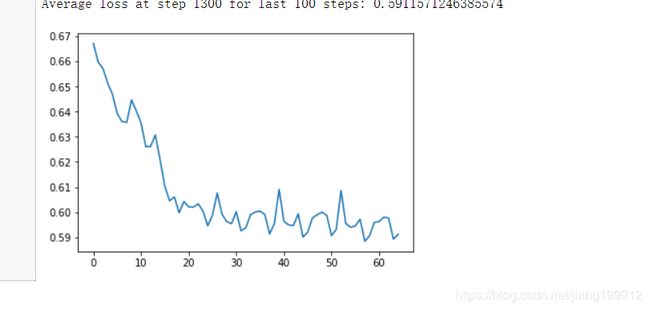lstm实现tensorflow不使用tf.nn.rnn_cell
本文是对上篇博客的代码改进,就是将rnn改成lstm。
具体的改动大约是这几个地方
1.lstm_cell实现
def lstm_cell(rnn_input, pre_output, memory):
#输入门
with tf.variable_scope('input_gate',reuse=tf.AUTO_REUSE):
wi = tf.get_variable('wi', shape=[num_classes+memory_size, memory_size])
bi = tf.get_variable('bi', shape=[memory_size], initializer=tf.constant_initializer(0.0))
wc = tf.get_variable('wc', shape=[num_classes+memory_size, memory_size])
ci = tf.get_variable('ci', shape=[memory_size], initializer=tf.constant_initializer(0.0))
it = tf.sigmoid(tf.matmul(tf.concat([rnn_input,pre_output], 1),wi)+bi) #shape=>[batch_size, num_classes]=>[batch_size,num_classes+memory_size]=>[batch_size,memory_size]=>[batch_size,num_classes+memory_size]=>[batch_size,memory_size]=>[batch_size,memory_size]
ic = tf.tanh(tf.matmul(tf.concat([rnn_input,pre_output], 1),wc)+ci)
#遗忘门
with tf.variable_scope('forget_gate',reuse=tf.AUTO_REUSE):
wf = tf.get_variable('wf', shape=[num_classes+memory_size, memory_size])
bf = tf.get_variable('bf', shape=[memory_size], initializer=tf.constant_initializer(0.0))
ft = tf.sigmoid(tf.matmul(tf.concat([rnn_input,pre_output], 1),wf)+bf)
#更新记忆
with tf.variable_scope('memory',reuse=tf.AUTO_REUSE):
c = memory*ft+ic*it
#输出门
with tf.variable_scope('output_gate',reuse=tf.AUTO_REUSE):
wo = tf.get_variable('wo', shape=[num_classes+memory_size, memory_size])
bo = tf.get_variable('bo', shape=[memory_size], initializer=tf.constant_initializer(0.0))
ot = tf.sigmoid(tf.matmul(tf.concat([rnn_input,pre_output], 1),wo)+bo)
ht = ot*tf.tanh(c)
#返回更新后的记忆与输出用于下一个lstm_cell的输入参量
return ht, c
在这里实现了一个简单的lstm单元,想实现多层lstm可以对此cell进行叠加。
代码实现依据我所写的这篇博客《lstm的理解》所写
其中形状的变化,大约是这样的变化过程:
shape:
=>[batch_size, num_classes] 这是刚开始输入时的shape
=>[batch_size,num_classes+num_classes]对输入与上一个时刻的输出进行concat
=>[batch_size,memory_size]与w进行矩阵乘法
=>[batch_size,memory_size]与偏置进行相加
2.对每一个时刻的输入进行计算
memory = init_memory
lstm_outputs = []
memory_outputs = []
for rnn_input in rnn_inputs:
pre_output, memory = lstm_cell(rnn_input, pre_output, memory)
lstm_outputs.append(pre_output)
memory_outputs.append(memory)
final_state = memory_outputs[-1]#保存这个batch最后一个memory,用于下一批的输入
3.具体代码如下
import tensorflow as tf
import pandas as pd
import numpy as np
import matplotlib.pyplot as plt
def get_data(size = 40000):
X = np.array(np.random.choice(2, size=(size)))
Y = []
for i in range(size):
threshold = 0.5
if X[i-3] == 1:
threshold += 0.5
if X[i-8] == 1:
threshold -= 0.25
if np.random.rand() > threshold:
Y.append(0)
else:
Y.append(1)
return X,np.array(Y)
def get_batch(x,y,batch_size,seq_length):
lens = len(x)
batches = lens//(batch_size*seq_length)
x = x[:batches*batch_size*seq_length]
y = y[:batches*batch_size*seq_length]
x = x.reshape(batch_size, -1)
print(x.shape)
y = y.reshape(batch_size,-1)
for i in range(0,(batches-1)*seq_length,seq_length):
raw_x = x[:,i:i+seq_length]
raw_y = y[:,i:i+seq_length]
yield (raw_x, raw_y)
def get_epochs(n, num_steps):
x,y=get_data()
for i in range(n):
yield get_batch(x,y, batch_size, num_steps)
batch_size = 3
num_classes = 2
state_size = 4
memory_size = 8
num_steps = 10
learning_rate = 0.1
"""
tf +
>>> import tensorflow as tf
>>> import numpy as np
>>> a = tf.constant(np.array([[1,2,3],[4,5,6]]))
>>> b = tf.constant(np.array([0,3,6]))
>>> c = a+b
>>> sess=tf.Session()
>>> sess.run(c)
array([[ 1, 5, 9],
[ 4, 8, 12]])
tf.unstack
>>> import numpy as np
>>> import tensorflow as tf
>>> sess = tf.Session()
>>> b = tf.constant(np.array([[0,1,2],[3,4,5]]))
>>> c = tf.one_hot(b,6)
>>> sess.run(c)
array([[[1., 0., 0., 0., 0., 0.],
[0., 1., 0., 0., 0., 0.],
[0., 0., 1., 0., 0., 0.]],
[[0., 0., 0., 1., 0., 0.],
[0., 0., 0., 0., 1., 0.],
[0., 0., 0., 0., 0., 1.]]], dtype=float32)
>>> d = tf.unstack(c,axis=1)
>>> sess.run(d)
[array([[1., 0., 0., 0., 0., 0.],
[0., 0., 0., 1., 0., 0.]], dtype=float32), array([[0., 1., 0., 0., 0., 0.],
[0., 0., 0., 0., 1., 0.]], dtype=float32), array([[0., 0., 1., 0., 0., 0.],
[0., 0., 0., 0., 0., 1.]], dtype=float32)]
>>> e = tf.unstack(c,axis=0)
>>> sess.run(e)
[array([[1., 0., 0., 0., 0., 0.],
[0., 1., 0., 0., 0., 0.],
[0., 0., 1., 0., 0., 0.]], dtype=float32), array([[0., 0., 0., 1., 0., 0.],
[0., 0., 0., 0., 1., 0.],
[0., 0., 0., 0., 0., 1.]], dtype=float32)]
>>> f = tf.unstack(c,axis=2)
>>> sess.run(f)
[array([[1., 0., 0.],
[0., 0., 0.]], dtype=float32), array([[0., 1., 0.],
[0., 0., 0.]], dtype=float32), array([[0., 0., 1.],
[0., 0., 0.]], dtype=float32), array([[0., 0., 0.],
[1., 0., 0.]], dtype=float32), array([[0., 0., 0.],
[0., 1., 0.]], dtype=float32), array([[0., 0., 0.],
[0., 0., 1.]], dtype=float32)]
"""
x = tf.placeholder(tf.int32, [batch_size, num_steps], name='inputs') #[batch_size, num_steps]
y = tf.placeholder(tf.int32, [batch_size, num_steps], name='targets')
init_state = tf.zeros([batch_size, state_size])
init_memory = tf.zeros([batch_size,memory_size])
pre_output = tf.zeros([batch_size, memory_size])
x_onehot = tf.one_hot(x, num_classes) #[batch_size, num_steps, num_classes]
rnn_inputs = tf.unstack(x_onehot, axis=1) #对数据进行分解 [num_steps, batch_size, num_classes]
def lstm_cell(rnn_input, pre_output, memory):
with tf.variable_scope('input_gate',reuse=tf.AUTO_REUSE):
wi = tf.get_variable('wi', shape=[num_classes+memory_size, memory_size])
bi = tf.get_variable('bi', shape=[memory_size], initializer=tf.constant_initializer(0.0))
wc = tf.get_variable('wc', shape=[num_classes+memory_size, memory_size])
ci = tf.get_variable('ci', shape=[memory_size], initializer=tf.constant_initializer(0.0))
it = tf.sigmoid(tf.matmul(tf.concat([rnn_input,pre_output], 1),wi)+bi) #
ic = tf.tanh(tf.matmul(tf.concat([rnn_input,pre_output], 1),wc)+ci)
with tf.variable_scope('forget_gate',reuse=tf.AUTO_REUSE):
wf = tf.get_variable('wf', shape=[num_classes+memory_size, memory_size])
bf = tf.get_variable('bf', shape=[memory_size], initializer=tf.constant_initializer(0.0))
ft = tf.sigmoid(tf.matmul(tf.concat([rnn_input,pre_output], 1),wf)+bf)
with tf.variable_scope('memory',reuse=tf.AUTO_REUSE):
c = memory*ft+ic*it
with tf.variable_scope('output_gate',reuse=tf.AUTO_REUSE):
wo = tf.get_variable('wo', shape=[num_classes+memory_size, memory_size])#由于要与memory进行矩阵乘法,所有要保证shape一致
bo = tf.get_variable('bo', shape=[memory_size], initializer=tf.constant_initializer(0.0))
ot = tf.sigmoid(tf.matmul(tf.concat([rnn_input,pre_output], 1),wo)+bo)
ht = ot*tf.tanh(c)
return ht, c
memory = init_memory
lstm_outputs = []
memory_outputs = []
for rnn_input in rnn_inputs:
pre_output, memory = lstm_cell(rnn_input, pre_output, memory)
lstm_outputs.append(pre_output)
memory_outputs.append(memory)
final_state = memory_outputs[-1]
#softmax
with tf.variable_scope('softmax'):
W = tf.get_variable('W', [memory_size, num_classes])
b = tf.get_variable('b', [num_classes], initializer=tf.constant_initializer(0.0))
#注意,这里要将num_steps个输出全部分别进行计算其输出,然后使用softmax预测
logits = [tf.matmul(lstm_output, W) + b for lstm_output in lstm_outputs]
predictions = [tf.nn.softmax(logit) for logit in logits]
# Turn our y placeholder into a list of labels
y_as_list = tf.unstack(y, num=num_steps, axis=1)
#losses and train_step
losses = [tf.nn.sparse_softmax_cross_entropy_with_logits(labels=label, logits=logit) for \
logit, label in zip(logits, y_as_list)]
total_loss = tf.reduce_mean(losses)
train_step = tf.train.GradientDescentOptimizer(learning_rate).minimize(total_loss)
def train_network(num_epochs, num_steps, state_size=4, verbose=True):
with tf.Session() as sess:
sess.run(tf.global_variables_initializer())
training_losses = []
#得到数据,因为num_epochs==5,所以外循环只执行五次
for idx, epoch in enumerate(get_epochs(num_epochs, num_steps)):
training_loss = 0
#保存每次执行后的最后状态,然后赋给下一次执行
training_memory = np.zeros((batch_size, memory_size))
if verbose:
print("\nEPOCH", idx)
#这是具体获得数据的部分
for step, (X, Y) in enumerate(epoch):
tr_losses, training_loss_, training_memory, _ = \
sess.run([losses,
total_loss,
final_state,
train_step],
feed_dict={x:X, y:Y, init_memory:training_memory})#training_memory将每个batch的最后一个记忆赋给下次执行
training_loss += training_loss_
if step % 100 == 0 and step > 0:
if verbose:
print("Average loss at step", step,
"for last 100 steps:", training_loss/100)
training_losses.append(training_loss/100)
training_loss = 0
return training_losses
training_losses = train_network(5,num_steps)
plt.plot(training_losses)
plt.show()
